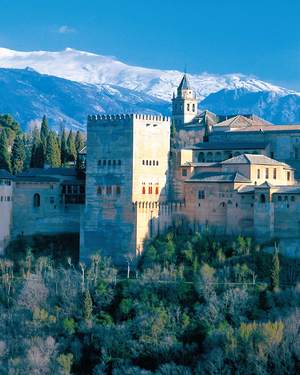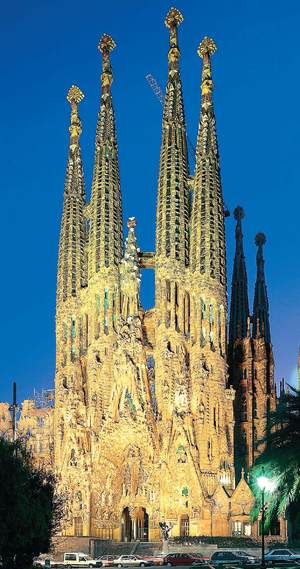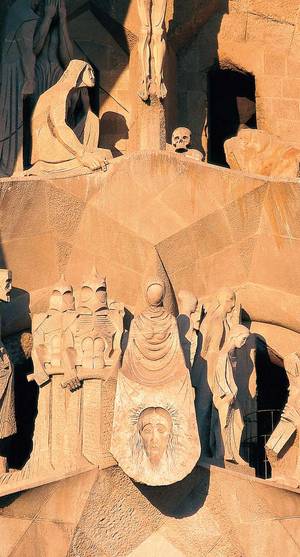Exploring the Treasures of Barcelona and Andalucia

My husband and I live in Glasgow, Scotland. For many years, we have motored about the United Kingdom and France in our VW camper van, but have always promised ourselves that, when we had the time, we would take a longer journey and drive down to Spain for the winter. Finally, we decided to stop talking about it and get on with it. So it was that one chilly January morning, we left our home on the south side of Glasgow and headed off for a two-month break in warmer climes.
Having had polio as a child, I wear a full-length caliper, and because my walking is restricted, I now use a manual wheelchair if faced with a distance further than that from house to motor vehicle. As we planned to do a lot of sightseeing, I had my wheelchair aboard, and a very helpful husband fully prepared to push when necessary. (If we had known how hilly Barcelona and Andalucia are, he might have opted to stay home!)
On the way, we stayed at a campsite in France. If you’re interested, do yourself a favour and buy the very helpful Alan Rogers Guide to campsites in France. This book tells you which sites are open and saves a lot of wandering around only to be met with a ferme sign. It also lets you know what the disability bathroom facilities are like at each site. We stopped for one night before heading over the border to Spain, and the site we stayed at in Chef Bouton was small and welcoming with a clean, accessible bathroom. It felt like a good start to our holiday.
Once over the Spanish border, we headed for Barcelona, first checking out our Spanish Alan Rogers guide to find a campsite close to the city. After setting up camp at El Masnou, about 10 kilometres west of Barcelona, we spent three days commuting by train into the centre of the city, savouring all this fabulous place has to offer. The commute proved to be fairly hair-raising as the only way onto the station platform from the campsite was across an extremely busy dual carriageway. Rather than use the stairriddled underpass, my husband would offer up a small prayer and then launch the chair and me through a gap in the traffic. In this way, we narrowly cheated death several times, but it gave a certain adrenaline edge to the twice-daily trip.
The tour buses in Barcelona are staffed by helpful, friendly people, but are not so wheelchair-accessible. We humphed ourselves on board anyway and proceeded to see all the sights.
Barcelona is possibly the most vibrant and stunning city I have ever seen, with its variety of architecture- gothic, medieval, modernist, baroque- encircled by wooded hills and overlooking the blue-green Mediterranean.

As the tourist bus drove up the Carrer de Sardenya, we were awestruck at the sight of Gaudi’s Sagrada Familia. This surreal building was designed to be a church, but its construction is ongoing. It resembles a glorious wrecked temple lying under the sea, its walls and spires swollen and blurred. On to Gaudi’s other fantastic folly- the park Guell, where we sat in the sun on the fabulous Banca de Trencadis, a tiled bench that curves around an area the size of a football pitch. Here we relaxed overlooking Gaudi’s landscaped gardens, his Hansel and Gretel houses and his colonnaded platform, on which a classical guitarist played. My husband recovered fairly quickly from the uphill slog of pushing the chair and, looking out at the view, agreed that it was well worth the effort.

Tearing ourselves away from Barcelona, we headed to the province of Murcia by taking the A7, the main coastal highway. It’s an amazing piece of engineering that runs for hundreds of kilometres from Barcelona in the north to Cadiz in the south, through often arid and rocky terrain, sometimes soaring over jaw-droppingly high viaducts.
Natural hot springs abound in Murcia. The village where we stayed, Banos de Fortuna, is full of people of all nationalities in bathrobes, wandering the streets in search of a thermal pool. There are several in the area renowned for their healing waters.
The campsite at Banos de Fortuna uses these springs to feed their pool, which is great for aches and pains! Every day, we spent a couple of hours lolling in the warm, salty water, and the old bones feel much better for it. The weather by mid-February was as warm as Scotland in May- perfect. This site is marvelous for those of us with mobility difficulties, as everything is easily accessed and, best of all, there are individual pitches, each with its very own shower and toilet facilities.
Eventually hauling ourselves out of the pool, one day we headed toward the interior of Andalucia. Here we were transported to a Spain that has its roots in an Islamic past, the Spain of Moorish cities such as Granada and Cordoba. The scent of cypress trees and the warmth of the spring sun filled our senses as we drove past small, whitewashed villages and orchards crammed with oranges and cherry blossoms. And then, a moment of awe as the mighty snow-covered peaks of the Sierra Nevada reared up to the east- the gateway to Granada. Here we made our way to the spectacular Alhambra, the 13th-century site of the Nasrid sultans.
At the height of summer, the Alhambra sees 6,000 visitors per day, but because it was early spring, only a few were there to view the remains of the centre of the Moorish occupation of southern Spain. In the Nazaries palace, the coolness of the marble and stone floors must be a godsend in the heat of midsummer. We admired the intricate wooden carvings and vaulted plasterwork with its profusion of star shapes suggesting the heavens and infinity. Courtyards lead off from the tranquil interior rooms and are filled with trees, gardens and ponds. The Alhambra is easily accessible if you use a wheelchair. There are spots where you will be faced with a staircase, but there is usually an alternative route.
Next, we moved on to Cordoba, where we visited the fabulous Mezoutia, originally a mosque. Visitors enter through arched marble pillars that create circular spaces, giving a sense of eternity and infinity, all decorated with simple, beautiful, geometric patterns. As we approached the centre of the ancient building, the atmosphere changed dramatically as we realized the heart has been ripped away and transplanted with a new centre- a cathedral built in the 15th century to affirm the Catholic conquest of Moorish Spain.
From Andalucia we made our way to rejoin the A7 and began the drive north, heading home- but not before spending another week at the thermal pool. Our visits to the cultural centres of Spain were fantastic, but nothing is as good as a long, hot soak!
Vicki McKenna is the author of “A Balanced Way of Living: Practical and Holistic Strategies for Coping with Post Polio Syndrome.” Visit www.share.force9.co.uk.














